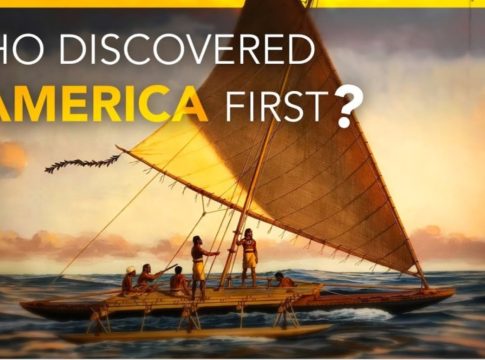The question of who “discovered” America is shrouded in intrigue and challenges our traditional understanding of exploration. While the popular narrative credits Christopher Columbus with this feat in 1492, a deeper examination reveals a more nuanced story.
This blog post delves into the ongoing debate surrounding the discovery of America. We’ll explore the prevailing theory of Columbus’s voyage, acknowledge evidence suggesting earlier arrivals, and analyze the significance of his encounter with the Americas.
The Columbus Narrative: A Pivotal Voyage and Its Lasting Impact
Christopher Columbus, an Italian explorer, remains the most prominent figure associated with the discovery of America. In 1492, funded by Queen Isabella I of Spain, he embarked on a westward voyage across the Atlantic Ocean in search of a new trade route to Asia. After a treacherous journey, Columbus landed in the Bahamas archipelago, mistaking it for the Indies. This pivotal moment, though based on a geographical miscalculation, marked the beginning of sustained European contact with the Americas.
Columbus’s discovery, however, wasn’t the first human encounter with the Americas. Archaeological evidence suggests that people from Asia, possibly traveling by Bering land bridge, had reached North America much earlier, potentially thousands of years before Columbus. These indigenous populations, with their rich cultures and established societies, had already inhabited the land for millennia.
The distinction that elevates Columbus’s voyage lies in its lasting impact. Unlike previous sporadic encounters, his arrival triggered a wave of European exploration and colonization that forever altered the course of history. This “Columbian Exchange,” as it’s known, resulted in a massive exchange of people, plants, animals, diseases, and ideas between the Americas, Europe, and Africa.
Beyond Columbus: Exploring Evidence of Earlier Arrivals
The theory of pre-Columbian contact with America is gaining traction as archaeological and genetic research shed light on potential earlier encounters. Evidence suggests the possibility of transatlantic voyages by Vikings, Polynesians, or even ancient Irish monks reaching the Americas before Columbus.
Here are some compelling examples:
- Norse settlements: Excavations in Newfoundland, Canada, have uncovered remnants of a Norse settlement dating back to the 10th century, suggesting Viking exploration of North America.
- Polynesian connections: Genetic studies reveal potential Polynesian contact with South America, evidenced by similarities in DNA between indigenous populations.
- Pre-Columbian transatlantic travel: Theorists argue that advanced seafaring techniques in certain pre-Columbian civilizations, like the Phoenicians, could have facilitated transatlantic voyages.
While these theories lack definitive proof, they highlight the possibility that Columbus wasn’t the sole discoverer. The vastness of the Atlantic Ocean and the limitations of historical records make it challenging to definitively prove or disprove these theories.
The Legacy of Columbus: A Reexamination of Exploration and Colonization
The celebration of Columbus Day has become a contentious issue in recent years. While some view him as a courageous explorer who opened new horizons, others point out the devastating impact of European colonization on indigenous populations.
The arrival of Europeans brought with it diseases like smallpox and measles, to which the indigenous populations had no immunity. These diseases ravaged native communities, leading to widespread death and population decline. Additionally, European colonization often involved violence, displacement, and the exploitation of indigenous resources and labor.
A more balanced understanding of Columbus’s legacy acknowledges both his role in initiating sustained contact and the tragic consequences of colonization.
The True Discovery: Recognizing the Rich Tapestry of American History
The concept of “discovery” in the context of America is a Eurocentric viewpoint. For the indigenous populations who had inhabited the land for millennia, the arrival of Europeans marked not a discovery, but a violent intrusion into their established way of life.
A more inclusive perspective acknowledges the rich tapestry of human history in the Americas before Columbus. Recognizing the presence and achievements of indigenous civilizations is crucial for a more complete understanding of American history.
Conclusion
The question of who discovered America is a complex one, with no easy answers. While Christopher Columbus’s voyage stands as a pivotal moment in history, it’s crucial to recognize the possibility of earlier encounters and the devastating impact of European colonization. Moving forward, a more nuanced understanding that celebrates the rich history of the Americas, both before and after 1492, is essential.
